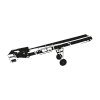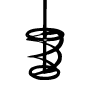The Unique SoRoTo® Mixing System
When Benny Andersen, founder of SoRoTo®, developed the unique SoRoTo® Mixing System, he knew he was on to something big, which is why he hurried up and patented his invention.
The 4 mixing blades on the steel system is designed to reach every corner of the mixer, and deliver an even, homogenous mix – fast. Most products are actually ready within 5 minutes.
Always remember to follow the guidelines on the material! There can be a huge difference between teh recommendations of different manufacturers.
Besides the number of mixer arms and the right angle on the blades, Benny wanted it to be easy to remove the mixing system – this is why you can of course remove the mixer arms without any tools.
It means, that the mixer is easily cleaned after use – and it is incredibly easy to change from steel to the rubber and rubber to steel, if you need to mix a different material all of a sudden.
Read our FAQ: How to maintain and clean my forced action mixer
The difference between rubber blades and steel blades
The reason why there are two different kinds of complete mixer systems is not that we designed a luxury model and a standard model, which some people think. They are simply designed for different uses.
The steel blades are best for most products. They grab hold of every last bit of material, if they are adjusted and angled correctly – and then the 4 arms streamline the process, makes it more efficient, and result in a finished mix in 3-5 minutes.
You should, however, use rubber mixer blades when mixing material containing aggregates, such as concrete. In fact, for all products with aggregates of 8 mm or bigger. The rubber system with the 3 rubber blades and rubber wedges in the cross joint can, without any problems, mix material with aggregates of up to 32 mm in diameter.
The rubber blades– combined with the rubber wedges in the cross joint – are designed to be flexible if a stone gets caught between the blades and the drum.
If you use steel blades on your mixer, when mixing material containing aggregates, the machinery has to use force in order to make the blades go round, if a stone gets caught. This can harm the drum and gears, and the mixer arms can bend or even break.
Should a stone get caught anyway, luckily the machine is designed with spring pins on top of the axel. These will bend or break rather in stead of the gears for instance – and they are much cheaper to replace. Read more about the spring pins here.
To conclude: it’s quite smart using rubber shovels for material containing aggregates, but the steel shovels are faster, among other things, because of the extra arm.
Did you ever wonder what the ”-30”, which is in front of your SoRoTo® Mixer after the size, for instance 100L-30
It means that your SoRoTo® Forced Action Mixer runs with 30 rounds per minute, which is the perfect speed for for mixing most products.
You have to beware of the speed of your mixer. If it mixes with too many RPM, the mixing time will rarely shorten. Instead the mix will become useless.
In some instances, the molecules activate too fast, if they overheat. The hardening will start too soon, and the mix will get lumpy and headed straight for the bin.
So let the machine do its work, and follow the manufacturer's instructions.
Some products are best whipped – that is, mixed with a lot of force. This is why we also offer a VARIO-model, that can be adjusted depending on what you’re mixing.
2 cement mixers in 1
When you purchase a SoRoTo® Forced Action Mixer, you choose whether you want a mixer system with steel or rubber blades.
The standard version of a small forced action mixer (40 L - 120 L) comes with steel shovels, and the large forced action mixers (200 L and 300 L) have rubber blades as a standard. A standard mixer system is always with 4 arms.
The reason why the standard version on the large 400 V-models is different from the small 230/110 V-models, is, that the larger machines are more often used for mixing material as concrete and mortar. And the small machines are preferably used for indoor masonry work such as plaster, tile cladding and screed.
We recommend purchasing the standard version, and then buying a complete set of the other mixer arm system on the side. This way you get 2 machines in 1, since the complete mixer system is easily removed and thus interchangeable.
FYI:
- SoRoTo® Forced Action Mixers 40L and 65-Light are not available with rubber blades.
If you're not sure which size your mixer is, you can find the different measurements here.
- The mixer arms wear out faster if you use the machine extraordinarily much or do not clean it well enough. In these instances, a new set of mixer arms can renew and prolong the machinery again and again.
If the arms and blades are adjusted correctly, they shorten the mixing time and better the quality of the mix. This reduces waste and lessens the need for cleaning. So make sure you keep your machinery taken care of, adjusted and cleaned.
- Remember, we also have the SoRoTo® Turbo Arm. The Turbo Arm replaces one of the regular arms on a SoRoTo® 300 L Forced action mixer. The Turbo Arm is meant solely for wall mortar, plaster mortar and other mixes with low viscosity, because, as it says in the text box above: many products will easily overheat if the machine runs too fast – but these products are better when whipped.
- Do you have an old, used forced action mixer with only two spring pins, it is no problem to mount a new set of mixer arms – even though it is meant for 4 spring pins. You can also buy new spring pins (if the old ones bend or snap) and drill new holes for them. A stencil, guide and drills are included in the package.
Are you curious to learn how to change them, read our FAQ: How do I change the spring pins?






















